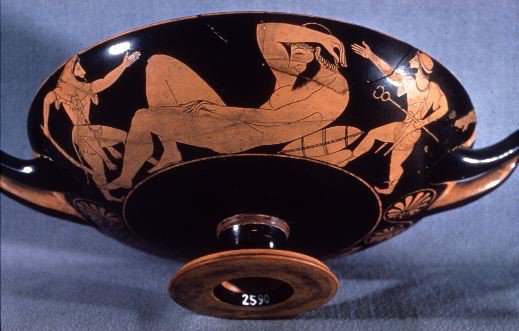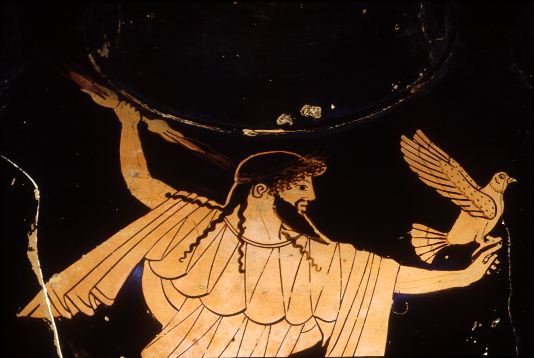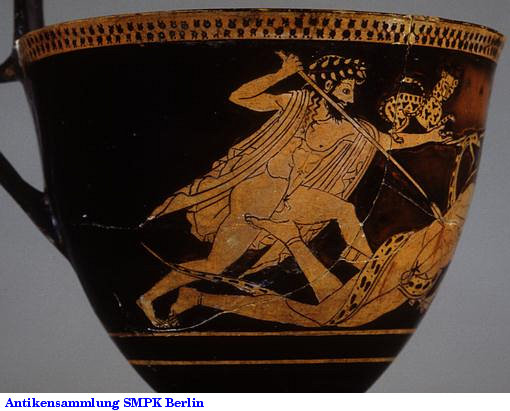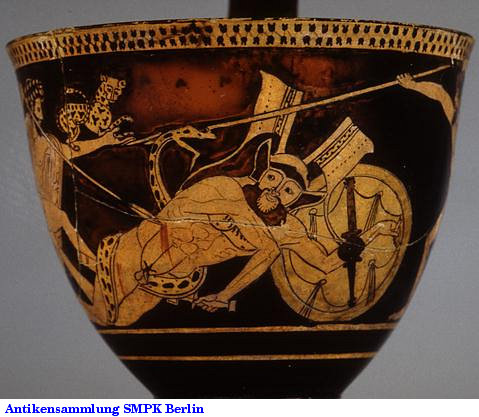Hercules and the Giants
Zeus wasn't always the king of the Greek gods. Ouranos was the king of the first generation of gods, but he was overthrown by Kronos, who was his son. Kronos was father to Zeus and the Olympians, and he, too, was overthrown by his son. Even after Zeus took charge, succeeding generations and different races of gods still competed for control of Olympus.
While Zeus was establishing himself, the Earth gave birth to a new, monstrous set of gods, the Giants, which were fathered by the Sky. The Giants were as tall as mountains and so strong as to be unbeatable. The Olympian gods were anthropomorphic, which means that they looked a lot like human men and women. But the Giants were frightening to look at. According to Apollodorus, their shaggy hair drooped from their heads and chins, and they had dragon scales on their feet.

Cleveland 78.59, Attic red figure lekythos, c. 480 B.C.
The shaggy giant Enkelados
Photograph courtesy of the Cleveland Museum of Art
The mightiest Giants were Porphyrion and Alkyoneus. Alkyoneus could remain immortal as long as he fought in the land of his birth, Pallene, in the region of Thrace. A bold troublemaker, Alkyoneus dared to steal some cows owned by the Sun. The Giants tossed house-sized boulders and burning oak trees at Mount Olympus to pass the time. They were not yet ready for an all-out attack.
Long ago the gods had received an oracle, or prediction of the future. This oracle declared that the gods could kill the Giants only if they had the help of a mortal. This mortal was Hercules. The Earth, who was the mother of the Giants, learned this too, and she tried to prevent Hercules from going to help the gods.
But Zeus had a plan. First he forbade the Sun from shining, then the Moon and the Dawn. Before anyone knew what was happening, he sent Athena with her chariot to bring Hercules up to Mount Olympus.
Alkyoneus was climbing up Mount Olympus, leading the other Giants. Hercules came to the cliff where he could see the monstrous Giants approaching. He drew his bow and shot Alkyoneus with an arrow that sank completely into the giant's shoulder. The giant lost his grip and fell to the ground unconscious, with an enormous crash.

Toledo 1952.66, Attic black figure lekythos, c. 510 B.C.
The giant Alkyoneus, unconscious at the base of Olympus
Photograph by Maria Daniels, courtesy of the Toledo Museum of Art
Soon Alkyoneus began to revive. But before he woke up completely, Athena told Hercules that Alkyoneus would not die unless he was outside of his birthplace, in Thrace. So Hercules dragged Alkyoneus far away, and there he died.

Munich 2590, Attic red figure kylix, c. 525 B.C.
Hercules sneaking up on the unconscious giant Alkyoneus, with Hermes helping at right
Photograph copyright Staatl. Antikensammlungen und Glyptothek, München
Meanwhile, Porphyrion had reached the top of Olympus. He had Hera cornered between the rocks and the sheer cliff. When Porphyrion began to attack the goddess, Hera called for help. Zeus cast his thunderbolt at Porphyrion, leaving him dazed, and Hercules, who had just rejoined the battle, shot him dead with an arrow.

Louvre G 204, Attic red figure Nolan amphora, c. 470-460 B.C.
Zeus with his thunderbolt
Photograph by Maria Daniels, courtesy of the Musée du Louvre
Now all the gods and Giants entered the fight. Apollo shot one of the Giants in the right eye, and Hercules shot him in the left eye. Dionysos killed one by whacking him with his thyrsus, or staff. Hecate set another Giant on fire with torches. Hephaistos eliminated one by pelting him with white-hot metal.
 |
 |
|
Berlin F 2321, Attic red figure kyathos, c. 510 B.C. Dionysos attacks the giant Eurytus, with help from a panther and a snake. Photographs by Maria Daniels, courtesy of the Staatliche Museen zu Berlin, Preußischer Kulturbesitz: Antikensammlung
|
|
Two of the Giants turned to flee. Athena caught the first one and imprisoned him under the island of Sicily; Poseidon broke off a piece of the island of Cos and threw it at the other. Hermes wore Hades' helmet and slew a Giant as he ran away, and Artemis killed another. Even the Fates killed a couple of Giants, fighting with clubs made of bronze.
Finally it was all over. Zeus had struck down the rest of the Giants with his thunderbolts, and Hercules finished them off where they lay.

Munich 596, Chalcidian black figure hydria, c. 540 B.C.
Typhon, the monstrous Giant
Photograph copyright Staatl. Antikensammlungen und Glyptothek, München
Earth, who had seen her children slaughtered by Hercules and the gods, was enraged. She now brought forth Typhon, a super-Giant. Typhon was half man, half beast. He was larger and stronger that any of Earth's other children. He was so tall that he towered over the highest mountains, and his head often brushed the stars. He was of human form down to his thighs, but he had huge snake coils instead of legs. When the coils were drawn out, they reached all the way to his head and let out a loud hissing. One of his hands reached out to the west and the other to the east, and from them projected a hundred dragons' heads. His body was winged: scruffy hair streamed on the wind from his head and cheeks; and fire flashed from his eyes. There would be a final contest between Typhon and Zeus, but that is another story.
(wpm)
- Hercules and Hesione, the princess of Troy
- Hercules and the struggle for the Delphic tripod
- Hercules and the Giants
This exhibit is a subset of materials from the Perseus Project digital library and is copyrighted. Please send us your comments.